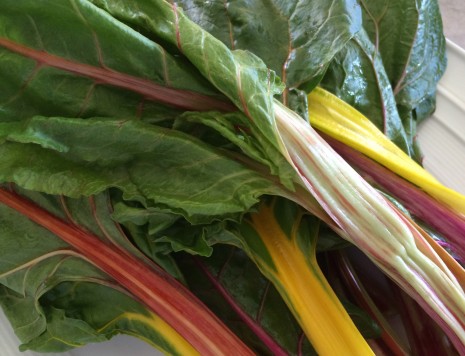CHARD FOR THE EASTER TABLE
Easter will be celebrated on the fly this year, so I’m keeping it ultrasimple—good smoked salmon to start, herb-crusted rack of lamb, boiled little potatoes, and something lemony for dessert.
As far as a green vegetable goes, the gorgeous rainbow chard I’ve been seeing everywhere has been pulling me in a Mediterranean direction. I do love a gratin, but that feels too heavy and wintry for April; instead I’m resurrecting (sorry) a Provençal favorite from The Gourmet Cookbook. Golden raisins, olives, and garlic provide sweetness, a bit of brininess, and depth of flavor to the greens, which turn from lightly crinkled, or savoyed, and fleshy to satiny when cooked. Although the stems, which need a slight head start in the pot, lose their vivid color, they become mild and firm-tender, and toasted pine nuts stirred in before serving add richness and crunch. The overall character of the dish is, well, suave, and far more than the sum of its parts—qualities lacking in so many recipes I see in magazines today.
So, okay, here’s what I know about chard. A member of the beet family, it gets its name from its prominent ridged stems, called, yep, chards. Front-loading “Swiss” onto the vegetable’s name confuses instead of clarifies: In Vegetables from Amaranth to Zucchini: The Essential Reference (2001)—an instant classic if there ever was one—Elizabeth Schneider notes that after 25 years of futile probing, she found no significant reason to keep the adjective. Even the international authority Brian Ford-Lloyd, of the School of Biosciences at the University of Birmingham, “could offer no more explanation than that ‘there is a Swiss national collection of leaf beet [and chard] genetic resources, which I assume means that the crop is of some importance to the Swiss.’ ” Chard was cultivated in ancient Greece and Rome, Schneider writes, and probably earlier in the Arab world.
I’m a relatively new convert to chard, by the way, and I think it’s because what I buy at the farmers market and supermarket is younger and fresher than it used to be. In overly mature leaves and stems, the minerally character of the vegetable veers into muddy; until I tasted it at its earthy, mellow best in the south of France, it was my braising green of last resort.
It’s easy dismiss the showy bouquets called rainbow chard as a “designer” variety, bred to appeal to consumers wanting the newest, brightest, shiniest toys at the market, but Schneider cites Sturvenant’s Edible Plants of the World, in which the author informs us that red chard was noticed by Aristotle about 350 B.C., and Theophrastus knew two kinds—the white and black, or dark green. In 1596, Bauhin describes “dark, red, white, yellow, chards with a broad stalk,” and Fearing Burr, in The Field and Garden Vegetables of America (1865 edition), includes five types, with green, white, purplish-red, and bright yellow stalks. The multicolored mix called Bright Lights has green or bronzed leaves with stems ranging from gold, pink, red, and orange to pastel variations; it was developed by the late New Zealand amateur breeder John Eaton, and seeds are available through Johnny’s Seeds and other sources. It’s fair to say that the flavor is milder and the texture is more tender than other chards.
One characteristic of rainbow chard that you may find as fascinating and otherworldly as I do is that the pigments in the stems carry through to the roots. Scroll down to see a photo I took last year of the hydroponic rainbow chard from Stokes Farm, at the Union Square Greenmarket. Easter egg colors!
[Swiss] Chard with Olives and Raisins
From The Gourmet Cookbook (Houghton Mifflin, 2004)
Serves 4
I know this recipe calls for 1½ bunches of chard, but it is very forgiving—and what in the heck are you supposed to do with that remaining half bunch? Use two bunches and add a smidge more of everything else. Save any leftovers to serve over pasta.
2 tablespoons olive oil
1 medium onion, finely chopped (1 cup)
1½ pounds Swiss chard (1½ bunches), center ribs discarded, leaves and stems separated, stems finely chopped, leaves coarsely chopped
¼ cup golden raisins
2 garlic cloves, finely chopped
8 Kalamata olives or other large brine-cured black olives, pitted and finely chopped
½ teaspoon coarse salt
¼ teaspoon freshly ground black pepper
¼ cup pine nuts, lightly toasted
1. Heat oil in a 5-quart heavy pot over moderate heat. Add onion and cook, stirring, until softened, about 3 minutes.
2. Add chard stems, raisins, and garlic, cover, and cook, stirring occasionally, until stems are tender, about 6 minutes. Stir in chard leaves, olives, salt, and pepper. Cover and cook, stirring occasionally, until leaves are wilted, about 3 minutes.
3. Remove lid and cook, stirring occasionally, until most of liquid chard gives off has evaporated and leaves are tender, about 4 minutes. Stir in pine nuts.
Posted: April 15th, 2014 under cookbooks, cooking, early spring, Gourmet magazine, recipes.



